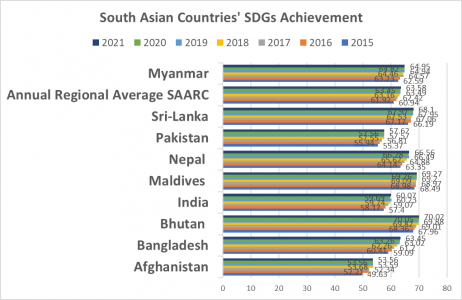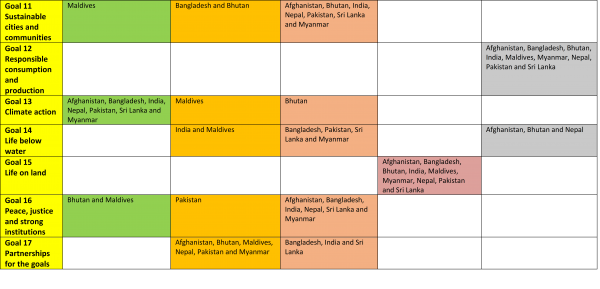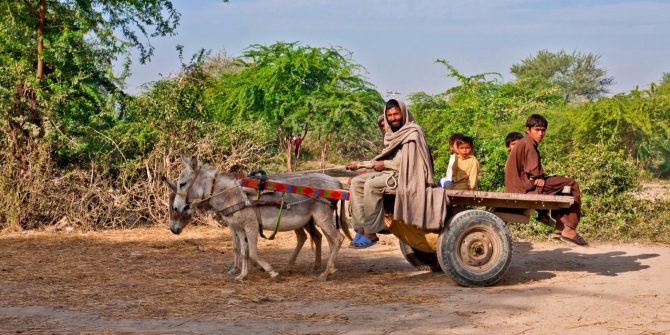Sustainable Development Goals (SDGs), first adopted in 2015, signalled a huge global effort towards building a fairer world. Globally, East and South Asia region made the greatest progress towards the goals after their adoption. In the wake of the COVID-19 pandemic, this populous area has struggled with advancing the SDG agenda but remained surprisingly stable. Abdur Rehman Cheema disaggregates the data from the latest SDG Index scores for the countries in South Asia to assess the impact of the pandemic and the way forward.
The Sustainable Development Report 2021 (SDR) is a joint annual publication of Sustainable Development Solutions Network and BertelsmannStiftung, published by the Cambridge University Press. The report has been written by a group of authors notably Professor Jeffrey D. Sachs, an American Economist. The report does not reflect the views of any organisation, agency or programme of the United Nations. An annual publication, the Sustainable Development Goals (SDGs) Index claims to track a country’s performance on the 17 SDGs. The report combines data and analyses produced by official and non-official data sources. Most of the data (around two-thirds) is developed by international organisations including World Bank, OECD, WHO, FAO, ILO and UNICEF. Where insufficient data are available for an official indicator, or to fill in data gaps, the report includes other metrics from official and unofficial providers.
It is not an official SDG monitoring instrument but instead complements efforts of national statistical offices and international organisations to collect data on and standardise SDG indicators. Owing to changes in the indicator selection, the 2021 rankings and scores are not comparable with last year’s results. The report shows countries’ performances at the goal and indicator level.
The 2021 report includes 91 global indicators as well as 30 additional indicators for OECD countries. The 2021 SDG Index covers 165 countries. One of the limitations regarding data availability is that to minimise biases from missing data, the SDG Index only includes countries that have data for at least 80 percent of the variables included in the global SDG Index.
The report highlights that the COVID-19 pandemic has been a huge setback for sustainable development. For the first time since the adoption of the SDGs in 2015, the global average SDG Index score for 2020 has decreased from the previous year: a decline driven to a large extent by increased poverty rates and unemployment following the outbreak of the COVID‑19 pandemic. Against this background,
one may be cautiously optimistic because the South Asian region has not slipped very much
though its overall progress still requires concerted action from all countries.
South Asian Countries’ progress 2015–2021
The index score signifies a country’s position between the worst (0) and the best or target (100) outcomes.
The countries are only grouped following their geographic region. The population context, level of conflict or issues of political stability are ignored. South Asian countries are categorised in the East and South Asia region that comprises 21 countries including China and Singapore, pushing the regional scores upward. Afghanistan is included in Eastern Europe and Central Asian region.
Despite COVID-19 global pushbacks, South Asian countries’ SDGs scores have marginally improved consistently since 2015 or stagnated but not deteriorated as shown in Figure 1. Progress in South Asia holds promise for 1.836 billion people, almost one-fourth of the global population though the pandemic is estimated to have caused 48 to 59 million people to become or remain poor in 2021 in South Asia region. Hit hard by the COVID-19 economic shock, between 2019 and 2020, South Asia’s annual GDP growth rate dropped to -5.7% from 4.04%.

Figure 1: Annual SDG scores 2015–2021 for South Asia, by country
Source: Based on data from Sustainable Development Report, 2021
South Asia’s average annual growth is forecast to be 3.4 percent over 2020–2023, which is 3 percentage points less than it was in the four years preceding the pandemic. Some of the South Asian economies will begin to recover in 2021–2022. According to the World Bank projections, India’s economy, South Asia’s largest, is expected to grow by 8.3 percent in the fiscal year 2021–2022. Recovery in exports and consumption will help growth rates recover and pick up to 6.4 percent in the fiscal year 2021–2022 in Bangladesh.
South Asia with an annual average Index score of 63.58 in 2021 means that the region is on average 63.58% on the way to the best possible outcome across the 17 SDGs. This score is 2.64% higher than the region’s baseline score in 2015, the year of the beginning of SDGs. With the ongoing curtailment of COVID-19 cases and start of the economic recovery, the region is poised to show better performance in the achievement of SDGs in coming years.
Within the South Asian region, the top three performers are Bhutan (70.02), Maldives (69.27) and Sri Lanka (68.1) respectively in 2021, and since 2015. From the bottom, Afghanistan (53.56), Pakistan (57.62) and India (60.07), remain the lowest performers in 2021 as they have been since 2015. Nepal (66.56), Myanmar (64.95) and Bangladesh (63.45) are middle performers in the region in 2021 and since 2015.
Delving into performance within the 17 Goals, most of the South Asian Countries face major challenges in achieving SDG 2 (Zero Hunger), SDG 3 (Good Health and Well-being), SDG 6 (Clean Water and Sanitation), SDG 9 (Industry, Innovation and Infrastructure) and SDG 15 (Life on Land). In particular, the performance of all the South Asian countries is off-track on SDG 15 (Life on Land) that relates to protecting biodiversity. Individual status of progress on SDGs is given below:
SDG Levels Per Goal, by Country




Colour Key

SDG Trends Per Goal



Source: Figures based on data from Sustainable Development Report 2021
Due to a low carbon footprint, most of the South Asian countries are on track to achieve SDG 13 (Climate Action). Performance on SDG 5 (Gender Equality) is stagnating in most of the South Asian countries.
Policy implications of this status report might recommend that regional platforms such as the South Asian Association for Regional Cooperation (SAARC) must be used for south–south learning. The Government of the Islamic Republic of Pakistan convened the First Meeting of the SAARC Planning Ministers on 25 November 2020. The meeting was devoted to the theme, ‘Achieving the Sustainable Development Goals (SDGs) in South Asia: Shaping the SAARC Vision–2030’. The Meeting agreed to revitalise regional approaches to successfully attain the Sustainable Development Agenda–2030, particularly in respect of poverty, food security, hunger, health, education, inequality and financing for sustainable development.
SAARC countries lack the fiscal space to finance emergency response and investment-led recovery plans aligned with the SDGs. The Planning Ministers’ meeting also raised an important point for collectively raising a voice for debt relief and the availability of concessional financing for the SAARC region to tackle the COVID-19 pandemic proficiently.
There are several opportunities for South–South learning and adopting regional approaches. Achieving SDGs is a globally shared responsibility: an agenda for the whole world, all SDGs are interconnected with each other. A collective approach that enhances regional economic integration in one of the worlds’ least connected economic regions, can offer huge dividends to increase the quality of life of the people.
The SDR 2021 shows that the Maldives and Bhutan are the only two South Asian countries on track to achieve SDG 16 (Peace, Justice and Strong Institutions). Maldives is the only country in the region that is on track to achieve SDG 7 (Clean Energy) and SDG 11 (Sustainable Cities and Communities). Case studies should be developed, and knowledge exchanges should occur among SAARC countries to leverage this knowledge and best practice collaboration to improve the lives of the people of this region.
Banner Image: Photo by Gustavo Quepón on Unsplash.
The views expressed here are those of the author and not of the ‘South Asia @ LSE’ blog, the LSE South Asia Centre, or the London School of Economics and Political Science.








Doctor Cheema
Such nicely presented real situation. We all need to be serious about these points to achieve the set targets. Good luck